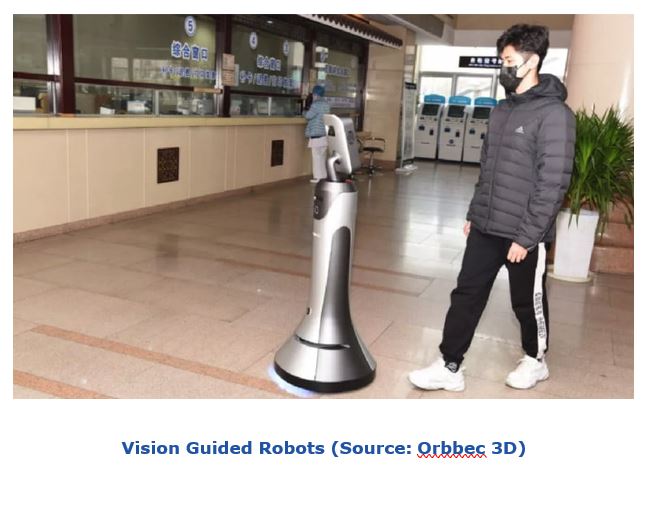

Robotics and machine vision play an important role in fighting the COVID -19 pandemic. Over one million people globally have been infected with COVID -19 virus. As the world continues to fight the novel coronavirus pandemic, leveraging robotics and machine vision technology can be a significant solution to safeguard people, control and prevent the spread of the virus. These cutting-edge technologies not only help in pharmaceutical and medical device manufacturing processes but also inspect, identify, recognize, diagnose, provide assistance in treating the COVID patients.
Automation is on the front lines to fight the battle against COVID 19. Robots are being deployed at medical service facilities to treat patients to minimize human to human contact. Autonomous mobile robots are bringing supplies to people in order to maintain social distancing. The following applications are gaining traction in this current scenario of pandemic
COVID-19 has turned increased focus towards vision guided robots, which can reduce unnecessary human contact at medical facilities and hospitals. For instance, Orrbec, a US-based company has collaborated with robot manufacturers in China where its 3D camera products are being deployed in robots for different hospital applications. Food delivery robots, sterilization robots, and directional guiding robots navigating patients between hospital departments, have been deployed across many hospitals in China.

China has deployed 5G patrol robots in public places, airports and shopping malls, which reminds people to wear face masks and wash hands, and monitors mask-wearing and body temperatures of people assisting police in prevention inspections. Guangzhou Gosuncn Robot Company has developed the robot, powered by an IoT edge computer (MIC-770) from Advantech, equipped with an 8th gen Intel Core I processor and GPU iModule (MIC-75G20) aimed at IoT applications. The robot has five high-resolution cameras and infrared thermometers that can scan the temperature of 10 people simultaneously within a radius of 5 meters. Any potential risk observed, like absence of mask or high temperature, results in an alert being sent by robots to relevant authorities, and a real-time response can be initiated.
Chinese startup UDI developed a self-driven robot van, Hercules, for logistics application. It delivers food to lockdown areas. The robot uses LIDAR, stereo vision cameras, and deep-learning algorithms to drive itself, carrying up to 1,000 kilograms on its cargo compartment. The company plans to mass produce these autonomous logistics robots in coming years.
Drones with specialized sensor and computer vision system are deployed to identify people with infectious and respiratory ailments. It has also become a key tool for safe transport of medical and other consumer supplies, medical sample delivery and aerial spray disinfection.
Disinfectant robots have been increasing since the outbreak of the pandemic. Danish disinfectant robots from UVD Robots have been deployed in all Chinese provinces to help fight the coronavirus. This self-driving robot platform, disinfects and kills diseases, viruses, bacteria, and other types of harmful organic microorganisms in the environment by breaking down their DNA-structure with help of UV light system. The production of these robots has accelerated, and sales are up in China, Asia and Europe. Similarly, Siemens and Aucma have developed a prototype of an intelligent disinfection robot that will soon be available to combat the virus spread.
These are just few examples where robots and vision technology have taken charge to meet the non-human labor demand in this pandemic situation. While demand for robotic and vision applications increases many fold in healthcare, medical and pharmaceutical sectors, robotics and intelligent manufacturing automation would be the key solution for manufacturing industries to mitigate the impact of present and future potential epidemic challenges. No one knows when this pandemic will end, but these critical automation technologies can be harnessed for the revival of industrial production, and it’s time that manufacturers upgrade their facilities with automation tools and digital technologies for safe and ongoing operations.

